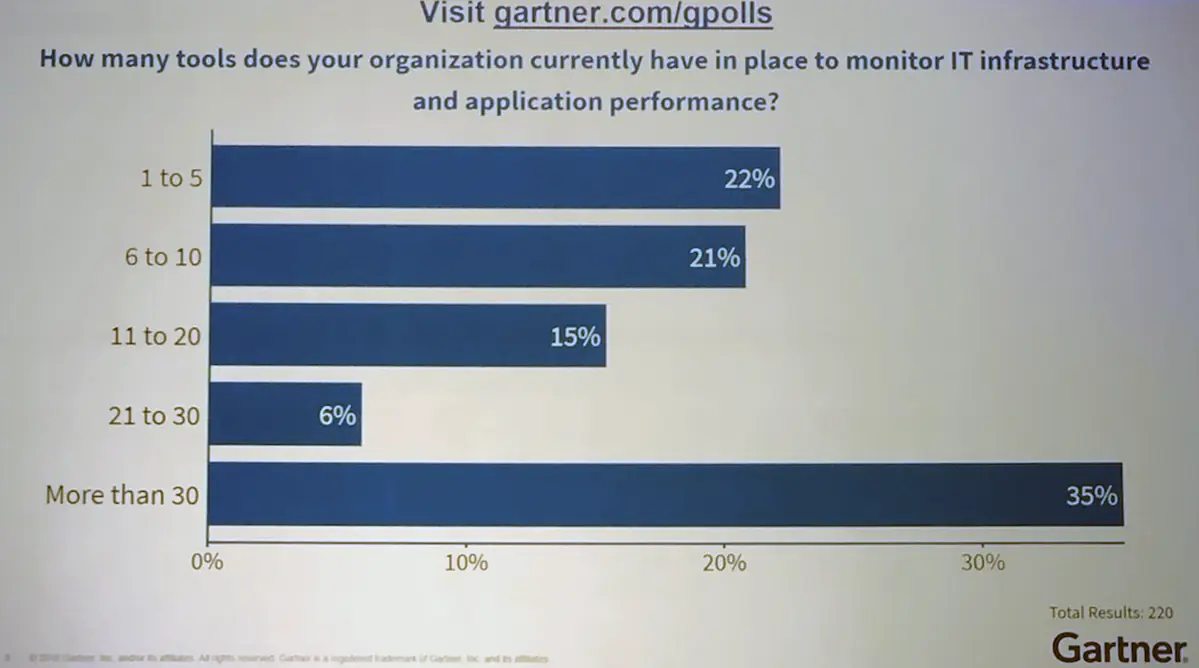#1: Topology-Based Monitoring
The current generation of monitoring solutions lack the ability to provide real-time insight into dependencies between infrastructure, application and business process components. They only monitor single components or a part of an IT landscape with metrics, logs or traces. The interpretation of how all these components work together to troubleshoot and understand the health of a service is always left to the different teams.
To truly understand what's going on across the systems in your IT landscape a context must be placed around the data. That context is topology. Using topology as part of troubleshooting and predictive analysis will greatly increase its accuracy and effectiveness. Capturing where events occurred and their up and downstream dependencies using graph- and bottleneck analysis can provide great insight on where to focus remediation efforts.
#2: Consolidation To End The Monitoring Tool Sprawl
Enterprise IT organizations are struggling with monitoring tool sprawl. A variety of tools are used to monitor every corner and aspect of their infra and applications. Cloud monitoring, APM, infrastructure monitoring, container monitoring, log aggregators and so on. IT teams easily get drowned in a sea of metrics, traces, logs and dashboards when shit hits the fan.
A recent poll during the Gartner I&O Summit in Las Vegas highlights this problem:

Consolidating these tools and datasets into a single platform will end the monitoring tool sprawl and will finally give teams the context and insights they need to solve issues quickly and work more efficiently. Download our latest white paper to learn how you can get started with consolidation your datasets.
#3: Increased Complexity With Kubernetes
As organizations strive to accelerate development and IT Operations they are increasingly adopting Kubernetes to enable their cloud-native applications and to modernize their IT infrastructure.
But be aware. Container environments don’t operate like traditional ones.
To ensure a good performance of your business service it is critical to monitor Kubernetes itself as well as the health of your deployed applications, the containers and the dependencies between them. The new abstraction introduced by Kubernetes, requires you to rethink your monitoring strategy, especially if you are used to traditional monitoring tools and traditional hosts such as physical machines or VMs. Microservices have changed the way we think about running services on VMs, but Kubernetes has changed the way we manage and scale containers.
#4: From One Cloud To Multi-Cloud
Moving from one cloud to a multi-cloud environment will become a necessity, especially among large enterprise IT organizations. As the scale of IT Operations grows, I&O leaders will require more flexibility from the new services they employ. And let's be honest. There are a lot of benefits that come from not having all your eggs in one basket. Benefits, such as improved reliability, avoiding vendor lock-in, cost savings and performance optimization are all critical to meet the demands of today's digital businesses. But, a multi-cloud strategy also puts more pressure to keep things up and running. It will be key for IT Operations to know what's going on from an observability, availability and performance perspective. In addition to this, they also need insight into the web of ever-changing relationships and interdependencies that exist across this data to be able to draw out meaningful conclusions.
#5: AIOps Will Be Hot
All classic and legacy monitoring vendors will rebrand their solutions and jump on the AIOps bandwagon in an attempt to differentiate against each other. As a buyer, it's hard to notice the difference between the solutions. In 2019 you will see AIOps vendors that apply AI as a layer on top of a broad range of monitoring data and you will have vendors that apply AI within their domain-centric monitoring data (such as the classic APM vendors).
According to Gartner, "Domain-centric monitoring tools will continue to exist, providing data capture, analysis, and visualization of their domains for the specialist. However, they will forward their data streams to an AIOps platform, acting as a lens where the data will be focused into a single, coherent, cross-domain analysis".
#6: AI And ML Will (Finally) Take Off In IT Operations
2019 will be the year of cutting through the hype and revealing the true value of AI and ML capabilities. Enterprise IT organizations will adopt AI and ML for IT Operations to improve support, automate cumbersome tasks, optimize infrastructure and predict issues.
StackState, an AIOps vendor, is already taking the next steps into AI and ML with Automated Pre-Mortem Analysis (APMA). By way of artificial intelligence, APMA combines information for a predicted incident and its consequences into a post-mortem-like report, before the incident impacts your business, avoiding high-severity outages. What predictions do you have for 2019?



